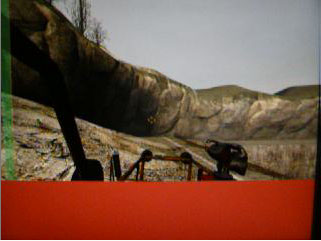Why you need the inter-GPU connector
So what's the inter-GPU connector for, be it a ribbon thing or a PCB? As SLI is running, data is being transferred between the GPUs to help synchronise rendering, query the framebuffer and copy framebuffer contents to the primary device, if I understand it correctly. I had a theory that once an SLI 'transaction' was up and running, all that happened across the PCI Express host. It appears not.To see if that was the case, I engaged Half Life 2 in SFR mode, started a timedemo run (an Anandtech demo at 1600x1200 with 8x AF and 4x AA, for the interested) and pulled the cable out and replaced it, three times, to see what would happen. The results were interesting and also kind of cool, so I filmed them. I've got a few frame grabs from the video and also the video itself. You can first see the frame before I pull the cable out the first time, then the frame directly after. It stops rendering entirely and the bottom of the screen, precisely at the point of load balancing, goes red. That's because I've removed the cable connecting the secondary (bottom) card, so it's rendering contribution isn't being added to the final framebuffer. That's then detected and rendering halts. It then resumes when you replace it, with nary a hitch.
I've then got a picture of another frame where the cable is removed, to show you that random data is used to fill the image out.



You can get the 4MB video here. It requires XviD/ffdshow to playback in your favourite media player.
The performance overlay
I showed you a checkbox to enable a hardware overlay of just what SLI is doing, here. Enabling it gets you a no performance loss overlay of how the system is load-balancing your rendering in SFR mode, CPU usage or AFR 'efficiency' (I assume) in AFR mode.Excuse my poor low-light photography at this point. That's Far Cry in SFR mode, being load-balanced. Notice the top-to-bottom green overlay and a horizontal bar showing you where the split is taking place. It moves up and down the screen dynamically, so you can see the split happening in real time. In that photograph, it's just below the 50/50 split mark (and Far Cry has crashed, again, hence no blurring in the image!).
In AFR mode you get a top-to-bottom green overlay again, however its the green bar that moves and the horizontal bar is static. The amount the bars are filled seems to denote CPU time in the driver, or some other such metric. The granularity in its movement suggests that it's not just a simple function of total buffered frames or something similar, although I might be wrong. The rule of thumb is if the green bars are full, performance is at its theoretical peak as the driver works hardest to get frames ready. Certainly, you can correlate less performance with less of the green bar being filled.
So it's useful in checking what SLI mode is being used and how performance is in any AFR mode.
Time to move on to performance in many ways, preceded by a quick look at the nForce4 SLI system specs I've been using for testing recently.










